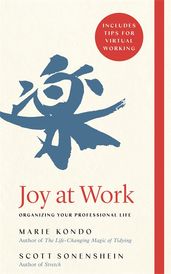Joy at Work
Synopsis
Find your focus with this transformative guide to organizing your work life.
From an organizational psychologist and Marie Kondo, the #1 New York Times bestselling author of The Life-Changing Magic of Tidying and star of the Netflix series Tidying Up with Marie Kondo.
Marie Kondo's first book, The Life-Changing Magic of Tidying, was an international bestseller. Now, for the first time, you will be guided through the process of tidying up your work life – digitally and physically.
Whether you're working at home, in the office, or a combination of the two, if you properly simplify and organize your work life once, you’ll never have to do it again.
In Joy at Work, KonMari method pioneer Marie Kondo and organizational psychologist Scott Sonenshein will help you to refocus your mind on what's important at work, and as their examples show, the results can be truly life-changing.
With advice on how to improve the way you work, including how to organize your digital and physical desktop, finally get through your emails and find balance by ditching distractions and focusing on what sparks joy.
'Marie Kondo’s magical book made me happier at work' – Stylist
Details
Reviews
Marie Kondo’s magical new book made me happier at work
A tidy guide to finding joy at work. Full of psychological wisdom and practical tips - I loved it!
Marie Kondo and Scott Sonenshein understand something very important about life and work: many times the key to success comes from subtracting, not adding. For anyone looking to bring more joy and focus to their office and career, Joy at Work is the book you've been waiting for.
Joy at Work is a charming antidote to the messiness of organizational life. It will help you be happier, waste less time, and lead others -- and is mighty fun to read.




